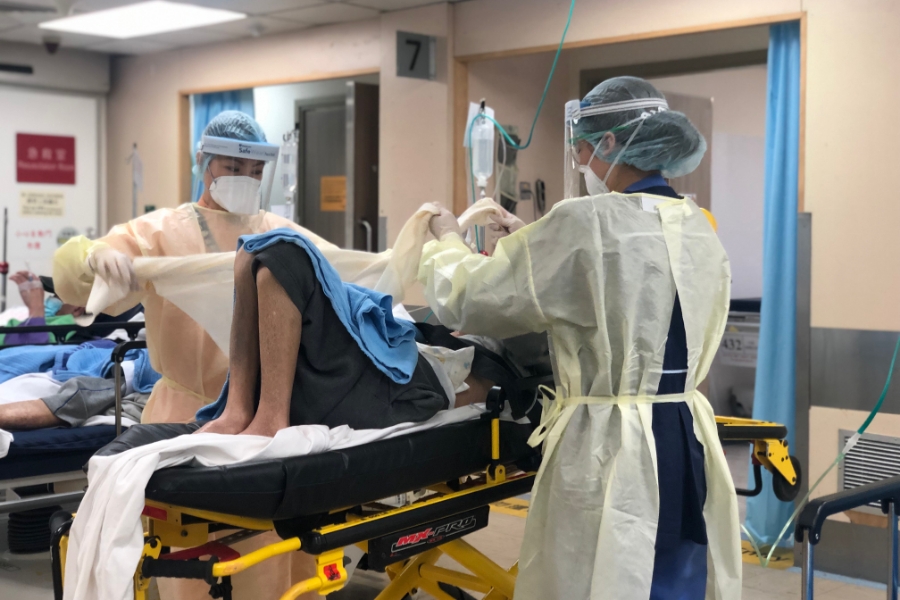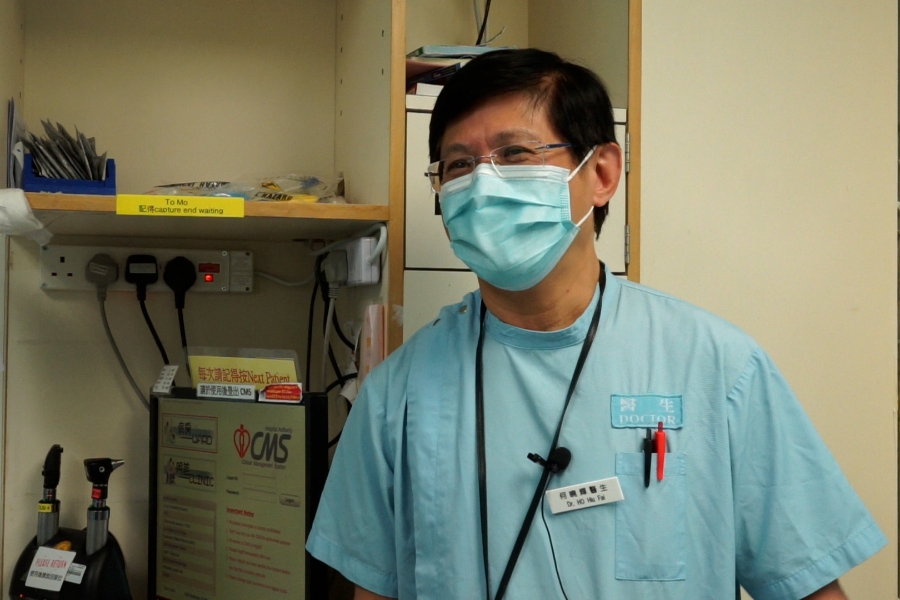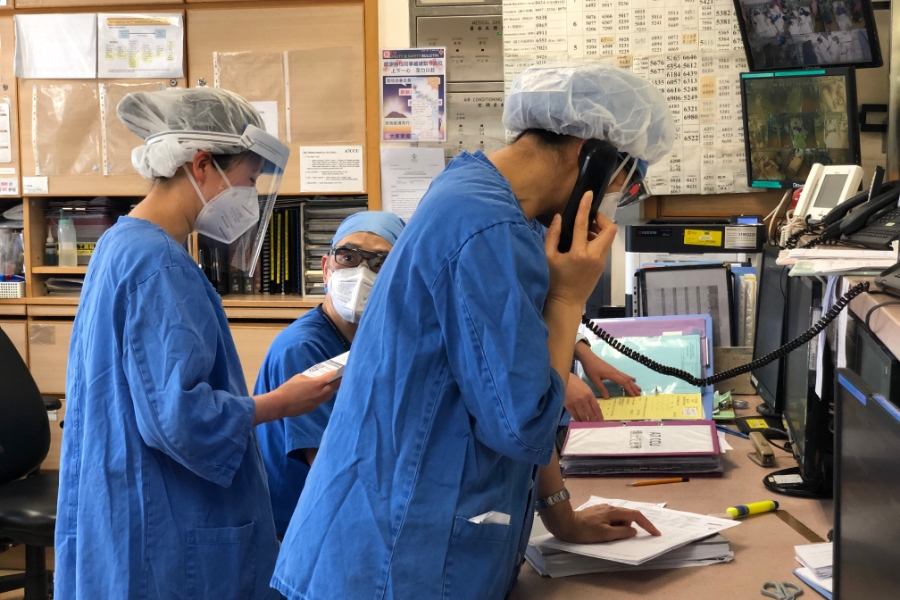Concerted team efforts accomplished conversion of QEH to designated COVID-19 hospital
The HA set up designated hospitals in various clusters to concentrate the management of COVID-19 patients since early March. Queen Elizabeth Hospital (QEH) of Kowloon Central Cluster was one of them.
 “The hospital had only two days to prepare for the conversion,” recalls Dr Ho Hiu-fai, Consultant of Accident & Emergency (A&E) Department of QEH. “Such kind of large-scale conversion has never occurred in Hong Kong public hospitals, to my knowledge. Understandably many colleagues were anxious of the change. Nevertheless, there were vast number of COVID-19 patients seeking consultation at QEH A&E. Inadequate in-patient beds resulted in admission block that increased the risk of cross-infection and affected patient care. Conversion was the only way-out.”
“The hospital had only two days to prepare for the conversion,” recalls Dr Ho Hiu-fai, Consultant of Accident & Emergency (A&E) Department of QEH. “Such kind of large-scale conversion has never occurred in Hong Kong public hospitals, to my knowledge. Understandably many colleagues were anxious of the change. Nevertheless, there were vast number of COVID-19 patients seeking consultation at QEH A&E. Inadequate in-patient beds resulted in admission block that increased the risk of cross-infection and affected patient care. Conversion was the only way-out.”
The conversion has created around 1,300 dedicated beds for COVID-19 patients at QEH. Multi-levels of beds were categorised for treatment according to patient’s clinical condition. Staff from all specialties participated. Patients in critical condition belong to Tier 1. Patients of lesser severity or relatively stable belong to Tier 2 and 3 respectively. Critical patient, after stabilisation, is transferred to lower tier. The arrangement can expedite turnover of hospital beds and ease prolonged waiting times. Multidisciplinary collaboration can be more targeted and strengthened.
Dr Ho (photo below) reckons that objective of the conversion and division of labour was clear. QEH was responsible for receiving COVID-19 patients and Kwong Wah Hospital admitting non-COVID-19 patients. He thanks Fire Services Department and other clusters for their support in accomplishing the mission. QEH was given the ‘breathing space’, two to three days before the conversion, by diverting and transferring COVID-19 and non-COVID-19 patients away. Lesson was learnt. “We will be able to make better and more efficient arrangement for future anti-epidemic situation.”

 “The hospital had only two days to prepare for the conversion,” recalls Dr Ho Hiu-fai, Consultant of Accident & Emergency (A&E) Department of QEH. “Such kind of large-scale conversion has never occurred in Hong Kong public hospitals, to my knowledge. Understandably many colleagues were anxious of the change. Nevertheless, there were vast number of COVID-19 patients seeking consultation at QEH A&E. Inadequate in-patient beds resulted in admission block that increased the risk of cross-infection and affected patient care. Conversion was the only way-out.”
“The hospital had only two days to prepare for the conversion,” recalls Dr Ho Hiu-fai, Consultant of Accident & Emergency (A&E) Department of QEH. “Such kind of large-scale conversion has never occurred in Hong Kong public hospitals, to my knowledge. Understandably many colleagues were anxious of the change. Nevertheless, there were vast number of COVID-19 patients seeking consultation at QEH A&E. Inadequate in-patient beds resulted in admission block that increased the risk of cross-infection and affected patient care. Conversion was the only way-out.”
The conversion has created around 1,300 dedicated beds for COVID-19 patients at QEH. Multi-levels of beds were categorised for treatment according to patient’s clinical condition. Staff from all specialties participated. Patients in critical condition belong to Tier 1. Patients of lesser severity or relatively stable belong to Tier 2 and 3 respectively. Critical patient, after stabilisation, is transferred to lower tier. The arrangement can expedite turnover of hospital beds and ease prolonged waiting times. Multidisciplinary collaboration can be more targeted and strengthened.
Dr Ho (photo below) reckons that objective of the conversion and division of labour was clear. QEH was responsible for receiving COVID-19 patients and Kwong Wah Hospital admitting non-COVID-19 patients. He thanks Fire Services Department and other clusters for their support in accomplishing the mission. QEH was given the ‘breathing space’, two to three days before the conversion, by diverting and transferring COVID-19 and non-COVID-19 patients away. Lesson was learnt. “We will be able to make better and more efficient arrangement for future anti-epidemic situation.”

“One day we will finish the race together”
Wong Kin-i, Department Operations Manager of the Department of O&T of QEH, recalls how – on the first day of the conversion – one ward received 30 patients within six hours but had only two nurses on the night shift. Their colleagues volunteered to stay up until the early hours of the morning to help out. “The transformation of the hospital was a huge project, which required the transfer of non-COVID-19 patients to other hospitals and the rapid familiarisation of colleagues from different departments with the new workflow,” she says. “For example, the Department of Obstetrics & Gynecology usually takes care of pregnant women and had never received male patients before the conversion, but we all volunteered to fill missing positions for each other. It made me feel that the epidemic is like a marathon. We may not be able to finish the race alone, but when there are people willing to pick up the slack, we will finish the race together one day.”
Dr Helen Chan, Associate Consultant of the Department of Medicine (Infectious Disease), was another key member of the team. She witnessed the patients suffering from waiting for admission in the cold weather outside the A&E Department and appreciated the enthusiasm of colleagues from all departments in caring for the COVID-19 patients. “Even though other departments had no experience in this field, they all worked together to help,” she says. “Colleagues from QEH are definitely loyal companions.”

Dr Helen Chan, Associate Consultant of the Department of Medicine (Infectious Disease), was another key member of the team. She witnessed the patients suffering from waiting for admission in the cold weather outside the A&E Department and appreciated the enthusiasm of colleagues from all departments in caring for the COVID-19 patients. “Even though other departments had no experience in this field, they all worked together to help,” she says. “Colleagues from QEH are definitely loyal companions.”
